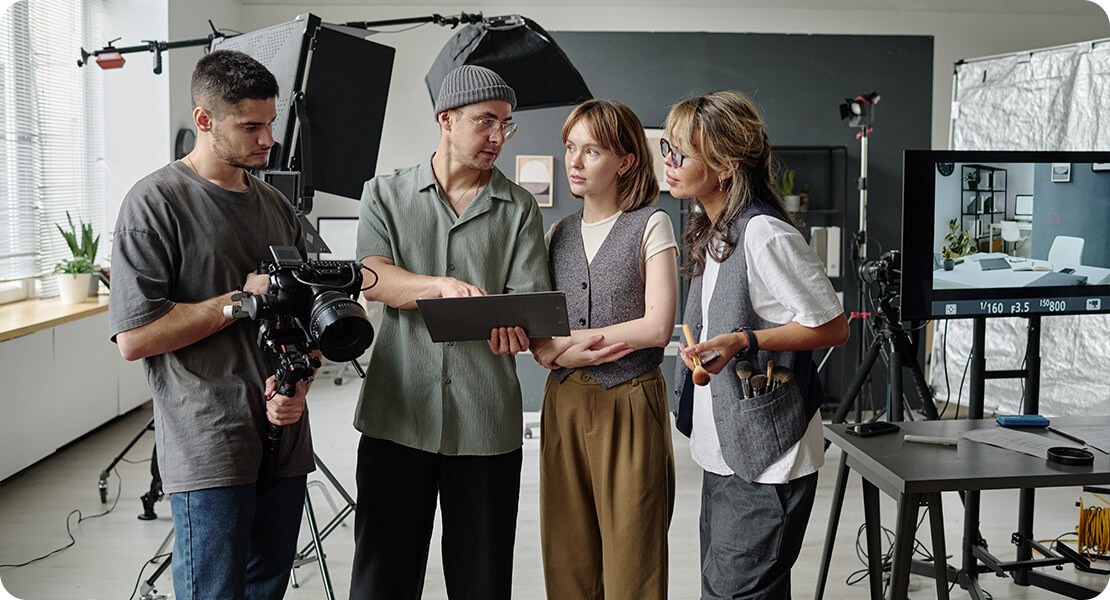
Video is the most powerful storytelling tool for businesses today—but just how much should you expect to pay for professional video production? The short answer: it depends. The long answer? It’s a blend of strategy, creative vision, production complexity, and the professionals you hire. In this article, we’ll break down the typical costs involved, what influences them, and how to get the most value from your investment—whether you’re filming a corporate promo, an explainer, a product demo, or a brand documentary.
The demand for video content is soaring across every platform—social media, websites, internal training hubs, and advertising channels. But with that demand comes a wide range of production options and budget levels. A quick social media clip can be made on a smartphone, while a polished brand film may involve an entire crew, studio hire, drone footage, and post-production specialists. That’s why understanding the key cost drivers is essential—not only to budget effectively, but also to make sure you’re investing wisely.
Whether you’re a start-up looking for your first product video or a marketing team planning a large-scale campaign, knowing where your money goes will help you make informed choices. It’s not about spending less—it’s about spending smart.
1. What Influences the Cost of Video Production?
Video production isn’t one-size-fits-all. Costs can range from a few hundred to tens of thousands of pounds. Here’s what typically affects the price:
- Video
length and complexity (e.g. 30-second social ad vs. 5-minute documentary)
Short videos generally cost less, but complexity can quickly change that. A fast-paced 30-second ad with special effects and multiple locations may cost more than a straightforward 5-minute interview. The more complex the structure—like including cutaways, motion graphics, or scene changes—the more time and money it takes to plan and execute. A longer video may also require more script development, shooting days, and editing time. Simpler formats, such as single-camera talking heads, are typically more affordable and faster to produce. - Type
of video (explainer, corporate, animation, testimonial, etc.)
Different formats come with different production needs. An animated explainer requires storyboard artists and motion designers, while a corporate video might need a live-action crew and professional actors. Testimonials are often more affordable if filmed on-site and with minimal equipment. Training videos or software demos might include screen recordings, voiceovers, or animations, all of which impact the price. Choosing the right format for your message can help balance cost and impact. - Crew
size and expertise
A basic shoot may only need one or two people, but a larger production could require a full team—director, camera operators, sound engineers, assistants, and more. Highly skilled crew members come at a premium, especially specialists like drone operators or lighting technicians. The more people on set, the higher the costs for labour, travel, and catering. Expert crews often work faster and deliver higher quality, reducing issues in post-production. However, hiring unnecessary crew for a simple video can inflate costs without adding value. - Equipment
and technology
Professional-grade cameras, lighting rigs, drones, and audio gear can significantly increase costs. High-end productions may also require specialty tools like stabilisers, sliders, or even green screens. Hiring gear per shoot day can quickly add up, especially if you need backups or multiple camera setups. The choice between 4K vs. 1080p, or renting vs. owning gear, also plays a role. Technology enhances visual quality, but must be matched with the project’s needs and budget. - Scriptwriting
and concept development
A strong concept and script are the foundation of a successful video. Professional writers or creative directors are often hired to craft a message that’s clear, persuasive, and aligned with brand goals. This process includes research, brainstorming, scripting, and sometimes storyboarding. A poorly planned script can lead to longer shoot times, unclear messaging, and higher editing costs. Investing in this stage can streamline the entire production and make the end product more effective. - Filming
locations
Shooting in a controlled studio is generally cheaper and more predictable than filming on location. However, on-location shoots can add authenticity and variety—but also come with logistical challenges. Travel, permits, weather contingencies, and location fees all add to the bill. Some sites may require insurance or health and safety compliance checks. The more exotic or remote the location, the more preparation and cost it entails. - Talent
(actors, voiceovers, presenters)
Hiring professional talent can elevate your video, but it does impact the budget. Rates vary based on experience, demand, usage rights, and union requirements. Well-known actors or influencers command higher fees and may require contracts. You may also need multiple takes, rehearsals, or wardrobe changes—all of which take time. Don’t forget to budget for makeup artists, stylists, or travel if talent is coming from out of town. - Post-production
(editing, animation, sound design)
This is where raw footage becomes polished content. Editing includes selecting takes, adding transitions, adjusting colour, syncing audio, and often incorporating graphics or branding. Animation or visual effects can dramatically increase the timeline and cost. Sound design—like music licensing, audio mixing, or Foley—adds professionalism but takes time. The more refined and high-quality the final video, the more post-production work it usually requires. - Delivery
format and revisions
Delivering a video in different formats—YouTube, Instagram, broadcast, etc.—may require different aspect ratios or edits. If you need subtitles, multiple languages, or accessibility features, those must be factored in. Most production companies include one or two rounds of revisions, but extra changes are often billed hourly. Clear communication and planning upfront can minimise costly revisions later. It’s also wise to clarify file formats and long-term access before final delivery.
2. Pre-Production Costs
Pre-production is the planning stage—critical for success. It lays the foundation for the entire video project and can determine whether the shoot runs smoothly or becomes a logistical headache. Every decision made during this phase—from script development to shot lists and schedules—directly impacts your timeline and budget downstream.
| Component | Estimated Cost (UK) |
| Scriptwriting | £300 – £2,000 |
| Storyboarding | £200 – £1,000 |
| Creative concept | £500 – £3,000 |
| Location scouting | £150 – £500 per site |
| Permits and insurance | £100 – £500+ |
| Project management | £300 – £1,500 |
A professionally written script ensures the message is clear, concise, and aligned with your objectives. Storyboards help visualise each shot before the camera rolls, which reduces on-set confusion and saves time during production. The creative concept is where ideas take shape, guiding everything from tone and style to visual treatment. Location scouting can reveal practical challenges—such as noise, lighting, or access issues—that might not be obvious on paper. Permits and insurance are essential for compliance and peace of mind, especially when filming in public spaces or with actors. And finally, dedicated project management keeps everything on schedule, ensuring coordination between your team, crew, and talent.
Pre-production ensures everything runs smoothly. Skimping here often leads to delays, last-minute changes, and inflated post-production costs. By investing time and budget upfront, you reduce risk, avoid surprises, and make the production process far more efficient.
3. Production Costs (The Shoot)

This is where the cameras roll. It’s the most visible part of the process, but also one of the most resource-intensive. Your crew, equipment, and the number of shoot days will define the bulk of your production budget. Every hour on set costs money, so meticulous pre-production planning can make this stage far more efficient and cost-effective.
| Component | Estimated Cost (Per Day) |
| Director | £500 – £1,500 |
| Director of Photography | £400 – £1,200 |
| Camera Operator | £300 – £800 |
| Sound Recordist | £250 – £600 |
| Production Assistant | £150 – £300 |
| Equipment Hire | £300 – £2,000+ |
| Studio/Location Hire | £200 – £2,000 |
| Talent (Actors/Models) | £250 – £1,500 |
| Catering/Transport | £100 – £500 |
The director is responsible for bringing the creative vision to life and managing on-set decisions. A skilled director of photography (DoP) ensures the lighting, framing, and camera movement align with the look and feel of the video. The camera operator handles the technical filming process, while the sound recordist captures high-quality audio—which is just as important as visuals. A production assistant helps with general support, making sure things stay on schedule and nothing falls through the cracks.
Equipment hire costs can vary widely depending on what’s needed—multiple cameras, lighting kits, lenses, stabilisers, or drones all come with added fees. Studio or location hire also depends on whether you’re filming in a professional studio or renting a unique on-site location, which may require permits or special arrangements.
Hiring professional talent adds authenticity and appeal, but their rates depend on experience, role complexity, and usage rights. Lastly, catering and transport may seem minor but are essential to keeping your crew energised and operations running smoothly, especially for longer shoots.
Smart scheduling, efficient crews, and minimal retakes can help reduce the number of shoot days—ultimately saving you time and money.
4. Post-Production Costs
Editing transforms raw footage into a polished final product. This is where your video takes shape—where pacing, tone, branding, and clarity all come together. Depending on complexity, post-production can be as simple as trimming a few clips, or as intensive as stitching together multi-camera footage, layering in effects, and engineering flawless sound. It’s also one of the most flexible stages in terms of time and cost.
| Component | Estimated Cost |
| Editing | £300 – £1,500+ per video |
| Motion Graphics/Animation | £500 – £5,000+ |
| Colour Grading | £200 – £800 |
| Sound Design/Mixing | £200 – £1,000 |
| Voiceover Recording | £150 – £700 |
| Subtitles/Captioning | £50 – £300 |
| Revisions | Often included, 1–2 rounds |
Editing is where the story is shaped and refined. Editors choose the best takes, build sequences, apply transitions, adjust timing, and sync the audio. For more advanced productions, this phase may also involve scene restructuring, adding B-roll, and integrating branded elements.
Motion graphics and animation can add energy, visual clarity, or stylistic flair—particularly for explainer videos, product demonstrations, or corporate intros. The cost depends on duration, detail, and whether 2D or 3D elements are involved.
Colour grading corrects and enhances the visual tone of the footage. It ensures consistency across scenes, adjusts exposure, and reinforces the mood—whether warm and friendly or cool and cinematic. Subtle adjustments can make your video look professionally polished.
Sound design and mixing ensure clear, balanced audio. This includes removing background noise, adding ambient sounds or effects, balancing music and dialogue, and giving your video a polished auditory finish. Poor sound quality can ruin a viewer’s experience, no matter how good the visuals are.
Voiceover recording is often required for explainer or educational content. Hiring a professional voice actor with the right tone and accent adds credibility and clarity to the message.
Subtitles and captioning are increasingly important for accessibility, social media platforms, and reaching multilingual audiences. They’re often an affordable but essential part of post-production.
Most production companies include one or two rounds of revisions in the price, but additional edits may be charged hourly. Clear direction during pre-production and review phases can help reduce the need for extensive changes.
More complex videos—especially those incorporating visual effects (VFX) or 3D animation—can significantly increase post-production timelines and costs. These projects may require specialist editors, software licenses, or render farms, particularly for technical, cinematic, or branded content at scale.
5. Animation and Explainer Videos

Animated videos involve a different workflow than live-action filming, but they can be incredibly cost-effective—especially for software, tech, healthcare, education, or service-based industries. They’re ideal for simplifying complex topics, visualising data or processes, and reaching audiences in an engaging, accessible way. Plus, animation avoids many of the costs tied to filming—like location hire, actors, equipment, and permits—making it a smart choice for evergreen content that can be used across multiple platforms.
| Animation Type | Cost per 60 Seconds |
| 2D Animation | £1,000 – £5,000 |
| Whiteboard Animation | £800 – £3,000 |
| Motion Graphics | £1,500 – £6,000 |
| 3D Animation | £3,000 – £15,000+ |
2D animation is one of the most versatile and widely used formats. It can be simple or highly stylised, depending on the brand and message. Ideal for explainers, onboarding, and social media, 2D is usually quicker to produce than 3D and offers strong visual storytelling with lower production overheads.
Whiteboard animation is popular for educational content. It involves hand-drawn illustrations (real or digital) that are revealed in sync with narration. This style is straightforward, cost-effective, and great for step-by-step explanations, but may lack the flair or dynamism of more advanced animation styles.
Motion graphics use animated text, icons, charts, and abstract visuals to communicate information in a sleek, modern way. This is especially useful for fintech, SaaS, or B2B industries that need to explain features or data-heavy concepts clearly. Costs vary depending on the level of customisation and the number of animated elements involved.
3D animation is the most visually impressive but also the most expensive and time-intensive. It’s suitable for high-end product demos, medical visualisations, architectural renderings, and anything that requires lifelike visuals or detailed models. Because of the technical expertise, rendering time, and complexity involved, 3D projects command a higher price tag.
Turnaround time and style complexity drive pricing. A simple whiteboard animation might take a couple of weeks, whereas a custom 3D render can take months. Revisions—especially after animation has been rendered—may be charged separately, so it’s crucial to lock in your script and visual direction early. Voiceovers, subtitles, and background music are also often billed as add-ons.
While animation can’t fully replace the emotional resonance of live-action, it excels in clarity, scalability, and versatility—especially when you need to educate, explain, or inspire in a visually consistent way.
6. Corporate and Brand Videos

Corporate video costs vary depending on whether you’re creating a customer testimonial, event highlights, internal training content, or a brand-defining company profile. These videos are often designed for long-term use—on websites, social media, or at trade shows—so production quality matters. The scope of the project, the number of shoot days, the style of storytelling, and the audience it targets will all influence the final cost.
| Type of Video | Typical Cost Range |
| Simple Interview (1 Day) | £1,000 – £2,500 |
| Brand Video (Multi-Day) | £5,000 – £20,000+ |
| Product Demo | £2,000 – £10,000 |
| Event Highlights | £1,500 – £6,000 |
| Training/E-learning | £2,000 – £8,000 per module |
A simple interview video typically involves one shoot location, a small crew, and minimal post-production. These are great for thought leadership, internal communications, or customer testimonials. Adding B-roll or graphics can increase costs slightly but boost engagement significantly.
A brand video is often the flagship piece of content for a company. These productions are typically multi-day shoots with larger crews, multiple locations, drone footage, actors or real staff, and cinematic editing. They showcase brand values, vision, and personality—so they require high production value and creative direction, which drives up the budget.
Product demo videos are ideal for showcasing the features and benefits of a specific product or service. These can range from simple studio shoots with voiceovers to more complex setups involving animations, live-action, and real-world use cases. They’re often used on e-commerce platforms, landing pages, or for sales enablement.
Event highlight videos are popular for trade shows, launches, and internal events. They usually require filming across an entire day or multiple days and involve capturing key moments, interviews, crowd reactions, and atmosphere. A well-edited highlight reel can help repurpose event footage for marketing, recruitment, or PR.
Training and e-learning modules are typically structured, scripted, and segmented videos designed to educate staff or customers. Costs can rise depending on the number of modules, animations, voiceovers, and whether interactive elements are included. These videos often require careful planning and compliance with internal or legal training standards.
Larger productions often include strategic planning, script development, storyboarding, and the purchase of long-term usage rights for music, talent, and stock footage. Companies investing in these types of videos should ensure the final product is scalable and can be repurposed across multiple channels for maximum ROI.
7. Additional Costs to Consider
- Music Licensing: £50 – £500+ depending on usage rights
- Stock Footage: £50 – £300 per clip
- Makeup/Wardrobe: £100 – £500 per day
- Translations: £100 – £500 per language
- Hosting/Delivery: Video platforms may incur ongoing fees
Always ask for a full cost breakdown or scope of work in advance to avoid surprise charges.
8. In-House vs. Hiring a Production Company
Hiring an agency or production house means access to experts, gear, and project management—but at a premium. Freelancers or in-house teams offer cost savings but may lack capacity or specialisation. Here’s a general guide:
| Option | Pros | Cons |
| Freelancers | Affordable, flexible | May need to coordinate multiple |
| In-house production | Full control, scalable | High upfront investment |
| Production companies | End-to-end service, high quality | Higher costs |
9. Average Price Ranges in the UK
To simplify, here are average project costs in the UK. These estimates cover a wide range of production styles and complexity levels, so actual prices may vary depending on your specific goals, duration, and technical requirements. They also assume professional-level production with a dedicated team, not DIY or in-house content creation. Always request a tailored quote based on your brief and intended usage.
| Video Type | Price Range |
| Basic Social Ad | £800 – £2,500 |
| Corporate Promo | £2,000 – £10,000 |
| High-End Brand Video | £10,000 – £50,000+ |
| Explainer Animation | £1,000 – £8,000 |
| Product Demo | £2,000 – £15,000 |
A basic social ad often includes minimal shooting or is built entirely from stock footage or animation, designed to be short and shareable. A corporate promo may involve on-site interviews, branded B-roll, and custom scripting. High-end brand videos are more cinematic, often requiring multi-day shoots, talent, location hire, and advanced post-production.
Explainer animations are ideal for clarifying services, workflows, or value propositions, especially for SaaS or B2B companies. A product demo, on the other hand, showcases features and usability, sometimes with animation overlays or voiceovers to improve engagement.
These ballpark figures are helpful for planning, but every video project is unique—so it’s always worth getting a detailed proposal based on your goals and creative vision.
10. How to Optimise Your Video Budget
Here are smart ways to stretch your budget:
- Batch filming: Shoot multiple videos in one day.
- Use your location: Avoid high studio fees.
- Hire locally: Save on travel costs.
- Limit revisions: Be clear on goals before editing.
- Repurpose content: Cut short clips for social media.
- Plan for scale: Think ahead—what content can be reused?
Final Thoughts: Investing Wisely in Video
Video is not just a cost—it’s an investment in brand storytelling, training, education, and sales enablement. Whether you’re spending £1,000 or £100,000, the key is clarity. Define your goals, audience, and distribution plan before picking up a camera.
A professional-looking video boosts trust, engagement, and conversions—but that doesn’t mean you need to overspend. With smart planning and the right partners, you can create compelling videos at almost any budget level.
If you’d like to take your video production to the next level at affordable prices, then get in touch with us here at Spiel for a free strategy consultation.

